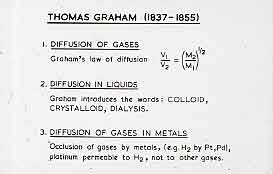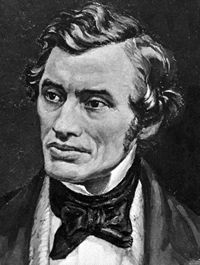|
History -Chemical History of UCL1836 Thomas Graham
He was a mainly a physical chemist, and he spent a lifetime's work on the study of molecular motion: initially in gases (Graham's law of effusion), then between gases and liquids, and then between gases and solids.  Some of this later work was carried out when he had left University College and become Master of the Royal Mint. In his work on coinage metals, he became interested in the fact that some metals, such as iron and nickel and particularly palladium would absorb large volume of hydrogen. Palladium will absorb 650 times its volume of hydrogen; this of course was the beginning of the story of cold fusion. Graham regarded this solid solution as an alloy of the volatile metal hydrogen, its volatility being restrained by the involatile metal palladium, and he had a medal struck of a solution of hydrogen in palladium, and presented it to Sir John Herschel who was his predecessor as Master of the Mint.
This page last modified 20 September, 2010 |

